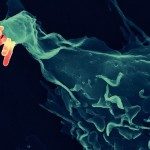Link to Pubmed [PMID] – 28701483
EMBO J. 2017 Sep;36(17):2567-2580
The role of second messengers in the diversion of cellular processes by pathogens remains poorly studied despite their importance. Among these, Ca(2+) virtually regulates all known cell processes, including cytoskeletal reorganization, inflammation, or cell death pathways. Under physiological conditions, cytosolic Ca(2+) increases are transient and oscillatory, defining the so-called Ca(2+) code that links cell responses to specific Ca(2+) oscillatory patterns. During cell invasion, Shigella induces atypical local and global Ca(2+) signals. Here, we show that by hydrolyzing phosphatidylinositol-(4,5)bisphosphate, the Shigella type III effector IpgD dampens inositol-(1,4,5)trisphosphate (InsP3) levels. By modifying InsP3 dynamics and diffusion, IpgD favors the elicitation of long-lasting local Ca(2+) signals at Shigella invasion sites and converts Shigella-induced global oscillatory responses into erratic responses with atypical dynamics and amplitude. Furthermore, IpgD eventually inhibits InsP3-dependent responses during prolonged infection kinetics. IpgD thus acts as a pathogen regulator of the Ca(2+) code implicated in a versatility of cell functions. Consistent with this function, IpgD prevents the Ca(2+)-dependent activation of calpain, thereby preserving the integrity of cell adhesion structures during the early stages of infection.
